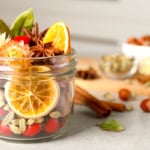9 Flowers That Make Great Companion Plants

There are many benefits to planting flowers alongside your herbs and vegetables. Companion planting reduces pests, increases food yield, and boosts pollination. Learn how to beautifully maximize the use of your space, prevent weed growth, and even improve the quality of your soil in the following article.
4 Reasons To Plant Flowers And Herbs Near Vegetables
Here are four reasons to plant flowers and herbs near vegetables in your garden, followed by nine suggested pairings.
1) Flowers And Herbs Repel Garden Pests
Marigold flowers are known to keep a variety of garden pests at bay. Have problematic aphids in your garden? Try planting garlic, leeks, and chives nearby. These plants naturally repel aphids. Other aphid repellants include catnip, dill, cilantro, and fennel. Slug repelling herbs include chives, garlic, mint, lavender, fennel, anise, wormwood, rue, and rosemary.
2) Flowers Provide Important Shade
Planting tall or vining trellised flowers may provide important partial shade for vegetables that prefer cooler temperatures. Sturdy, tall flowers may also add support to vegetables in your garden.
3) Add To Visual Interest and Appeal
Combining a variety of plant colors, shapes and sizes, layers, and textures together gives your garden a unique, artistic style that doesn’t occur when each is isolated in beds or rows. Imagine a charming cottage garden bursting with color and romanticism.
4) Attract Pollinators
Dense bursts of color attracts beneficial pollinators such as hummingbirds, butterflies, and moths to your plants. Some flowers produce more pollen than others. Wise gardeners pair those that don’t attract bees along with those that do.
9 ideal companion plant Pairs

Red Roses With Lavender – Attracts Bees
Did you know that bees can’t see the color red? Thus, red rose varieties tend to attract less bees. Help these essential pollinators by planting lavender nearby. Bees are most attracted to the colors purple and blue love lavender nectar love lavender nectar, so, so plant lavender nearby. This may lead to abundant, healthy blooms.
Lavender is a superb companion for roses as it produces nectar which attracts bees and has similar soil and sun requirements. Lavender will not soak up all the nutrients or water. Another bonus, lavender suppresses weed growth and will grow to a height to conceal the lower cane portion of rose bushes. Plus, fresh cut roses and lavender make a lovely bouquet!
Calla Lilies and Catmint – Repels Aphids
Calla Lilies are gorgeous, elegant flowers grown from rhizomes. Yet i’ts prone to aphid infestation. Catmint (not to be confused with catnip) is a lovely perennial herb with lavender-blue flowers and grayish-green leaves. The aromatic catmint doubles as a pest repellant, deterring aphids and other garden pests from ruining your calla lilies.
Catmint is easy to grow and low maintenance. Both plants prefer full sun, or partial shade in warmer climates. Plant calla lily rhizomes outdoors in spring, after the last spring frost. Fill in the empty spaces between calla lily plants with catmint. The shallow root system of catmint plants will not interfere with calla lilies.
Pansies and Parsley – Edible Landscaping!
Grow pansies and parsley together for edible garnishes and other culinary uses. Pansies are popular annuals that yield stunning, colorful low-growing flowers. The lacy green leaves of the parsley plant pair well with the lovely pansy. Plant both plants outdoors in early spring, where they’ll receive six hours of full sun daily. Pansies can also be planted in the fall.
Larkspur and Yarrow – Repels Slugs And Snails
The lovely larkspur is a cottage garden classic grown for its tall, cut flowers. Slugs and snails love dining on larkspur. Yarrow is a lovely flowering perennial herb that naturally repels slugs and snails.
Plant a border of yarrow around larkspur or between rows to keep these garden pests away from the larkspur flowers. As a companion plant, the tall yarrow flowering herb companion plant will also add support and structure to larkspur as it increases in height.
Dahlias and Rosemary – Repels Snails
Snails are known to feed on young dahlia leaves. Planting a strong-smelling herb that repels snails and other pests such as rosemary around or between dahlias protects the young plant from damage, so it matures and yields beautiful blooms you’ll love.

Sunflowers and Broccoli – Provides Shade For Brassica Veggies
When planted together, sunflowers add bursts of color and height to your garden, while providing partial shade to brassicas vegetables such as broccoli, Brussels sprouts, cabbage, and cauliflower. Broccoli and other brassicas vegetables prefer growing in cool weather. Sunflowers also attract lots of bees to help pollinate your vegetables. And then there’s a crop of edible seeds to harvest from the sunflower heads.
Daffodils and Lettuce – Keeps Rabbits And Deer Away
Daffodils contain a poisonous substance called lycorine that deer and rabbits avoid ingesting. Daffodils are an easy to grow, pretty spring-flowering bulb. They should be planted in the fall, several weeks before the ground freezes.
Daffodils thrive in full sun. Plant bulbs in a protective border around a lettuce bed to keep rabbits out of the vegetable garden. Lettuce is a favorite garden food of rabbits and deer. Lettuce is a cool weather vegetable, planted in early spring and/or fall. Although it grows best in full sun, early on, as the weather warms, partial shade keeps it thriving longer. The partial shade from the daffodils may help extend your lettuce growing season.
Nasturtiums and Bell Peppers – Attracts Hummingbirds
Nasturtiums add bright yellow-red color as it carpets your garden bed. This lovely ground cover reduces the need to weed around these nightshade plants: bell pepper, tomato, and eggplants. Nasturtium thrives well in full or partial sun. The entire plant is edible, and tastes peppery, like watercress. It’s often used in salads. Its super sweet nectar (sucrose) attracts hummingbirds and other pollinators.
Petunias and Tomatoes – Nature’s Pesticide
Did you know that pretty petunias act as a natural pesticide when planted in vegetable gardens? This popular perennial known for its abundant, colorful trumpet shaped flowers emits a chemical in the air that repels many pests including aphids, squash bugs, leafhoppers, asparagus beetles and tomato hornworms.
Petunias are the perfect protective companion when planted near tomatoes and other vegetables in your garden. Plant petunias and tomato plants outdoors in late spring or early summer in a sunny location.
Join The Discussion!
Have you ever planted flowers with your herbs or vegetables?
What are some companion plant pairs?
Let us know in the comments below!
Related Articles
Companion Plant Valentine Puns!

Deborah Tukua
Deborah Tukua is a natural living, healthy lifestyle writer and author of 7 non-fiction books, including Pearls of Garden Wisdom: Time-Saving Tips and Techniques from a Country Home, Pearls of Country Wisdom: Hints from a Small Town on Keeping Garden and Home, and Naturally Sweet Blender Treats. Tukua has been a writer for the Farmers' Almanac since 2004.






What is a strawberry companion?
Allisum around my tomatoes
The article mentions that petunias emit a chemical into the air that repels many insects. Can you identify it please?